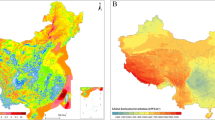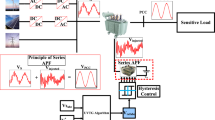Abstract
To support large-scale integration of wind power into electric energy systems, state-of-the-art wind speed forecasting methods should be able to provide accurate and adequate information to enable efficient, reliable, and cost-effective scheduling of wind power. Here, we incorporate space-time wind forecasts into electric power system scheduling. First, we propose a modified regime-switching, space-time wind speed forecasting model that allows the forecast regimes to vary with the dominant wind direction and with the seasons, hence avoiding a subjective choice of regimes. Then, results from the wind forecasts are incorporated into a power system economic dispatch model, the cost of which is used as a loss measure of the quality of the forecast models. This, in turn, leads to cost-effective scheduling of system-wide wind generation. Potential economic benefits arise from the system-wide generation of cost savings and from the ancillary service cost savings. We illustrate the economic benefits using a test system in the northwest region of the United States. Compared with persistence and autoregressive models, our model suggests that cost savings from integration of wind power could be on the scale of tens of millions of dollars annually in regions with high wind penetration, such as Texas and the Pacific northwest.










Similar content being viewed by others
References
Ackermann T (2005) Wind power in power systems. Wiley, New York. http://books.google.com/books?id=NcMws2-N3BMC
Bouffard F, Galiana FD (2008) Stochastic security for operations planning with significant sind power generation. In: Proceeding of power and energy society general meeting—conversion and delivery of electrical energy in the 21st Century, 2008 IEEE, pp 1–11
BPA (2007) BPA total transmission system load. Bonneville Power Administration
BPA (2010) 2009 BPA facts. Bonneville Power Administration
Constantinescu EM, Zavala VM, Rocklin M, Sangmin L, Anitescu M (2011) A computational framework for uncertainty quantification and stochastic optimization in unit commitment with wind power generation. IEEE Trans Power Syst 26(1):431–441
CREIA (2010) CREIA 2010 China wind power outlook. China Renewable Energy Industries Association
Denny E, O’Malley M (2006) Wind generation, power system operation, and emissions reduction. IEEE Trans Power Syst 21(1):341–347. doi:10.1109/TPWRS.2005.857845
DOE (2008) 20 % Wind energy by 2030: increasing wind energy’s contribution to U.S. electricity supply. The US Department of Energy
Doherty R, O’Malley M (2005) A new approach to quantify reserve demand in systems with significant installed wind capacity. IEEE Trans Power Syst 20(2):587–595
ERCOT (2010) ERCOT quick facts. Electric Reliability Council of Texas
EWEA (2012) Wind in power: 2011 European statistics. The European Wind Energy Association.
Genton MG, Hering AS (2007) Blowing in the wind. Significance 4:11–14
Giebel G, Brownsword R, Kariniotakis G, Denhard M, Draxl C (2011) The state-of-the-art in short-term prediction of wind power: a literature overview, 2nd edn. ANEMOSplus
Gneiting T (2011) Quantiles as optimal point forecasts. Int J Forecast 27:197–207
Gneiting T, Raftery AE (2007) Strictly proper scoring rules, prediction, and estimation. J Am Stat Assoc 201:359–378
Gneiting T, Larson K, Westrick K, Genton MG, Aldrich E (2006) Calibrated probabilistic forecasting at the stateline wind energy center: the regime-switching space-time method. J Am Stat Assoc 101:968–979
Grigg C, Wong P, Albrecht P, Allan R, Bhavaraju M, Billinton R, Chen Q, Fong C, Haddad S, Kuruganty S, Li W, Mukerji R, Patton D, Rau N, Reppen D, Schneider A, Shahidehpour M, Singh C (1999) A report prepared by the reliability test system task force of the application of probability methods subcommittee. IEEE Trans Power Syst 14(3):1010–1020
Gu Y, Xie L (2010) Look-ahead coordination of wind energy and electric vehicles: A market-based approach. In: Proceeding of North American power symposium 2010, The University of Texas, Arlington.
Hering AS, Genton MG (2010) Powering up with space-time wind forecasting. J Am Stat Assoc 105:92–104
Jeon J, Taylor JW (2012) Using conditional kernel density estimation for wind power density forecasting. J Am Stat Assoc 107(497):66–79. doi:10.1080/01621459.2011.643745
Kariniotakis G, Pinson P, Siebert N, Giebel G, Barthelmie R (2004) The-state-of-the-art in short-term prediction of wind power - from an offshore perspective. In: Procedding of symposium ADEME, IFREMER.
Makarov Y, Lu S, McManus B, Pease J (2008) The future impact of wind on bpa power system ancillary services. In: Proceeding of transmission and distribution conference and exposition, IEEE/PES.
Makarov Y, Loutan C, Ma J, de Mello P (2009) Operational impacts of wind generation on california power systems. IEEE Trans Power Syst 24(2):1039–1050. doi:10.1109/TPWRS.2009.2016364
Meibom P, Barth R, Hasche B, Brand H, Weber C, O’Malley M (2011) Stochastic optimization model to study the operational impacts of high wind penetrations in ireland. IEEE Trans Power Syst 26(3):1367–1379
Monteiro C, Keko H, Bessa R, Miranda V, Botterud A, Wang J, Conzelmann G (2009) A quick guide to wind power forecasting: stat-of-the-art 2009.
Papavasiliou A, Oren SS, O’Neill RP (2011) Reserve requirements for wind power integration: a scenario-based stochastic programming framework. IEEE Trans Power Syst 26(4):2197–2206
Pappala VS, Erlich I, Rohrig K, Dobschinski J (2009) A stochastic model for the optimal operation of a wind-thermal power system. IEEE Trans Power Syst 24(2):940–950
Pinson P, Madsen H (2012) Adaptive modeling and forecasting of wind power fluctuations with markov-switching autoregressive models. Int J Forecast 31:281–313
Soder L (2004) Simulation of wind speed forecast errors for operation planning of multiarea power systems. In: Proceedinf of probabilistic methods applied to power systems, 2004 international conference on, pp 723–728
Tastu J, Pinson P, Kotwa E, Nielsen H, Madsen H (2011) Spatio-temporal analysis and modeling of wind power forecast errors. Int Stat Rev 14:43–60
Tuohy A, Meibom P, Denny E, O’Malley M (2009) Unit commitment for systems with significant wind penetration. IEEE Trans Power Syst 24(2):592–601
Wang J, Shahidehpour M, Li Z (2008) Security-constrained unit commitment with volatile wind power generation. IEEE Trans Power Syst 23(3):1319–1327
Watson SJ, Landberg L, Halliday JA (1994) Application of wind speed forecasting to the integration of wind energy into a large scale power system. Gener Transm Distrib IEEE Proc 141(4):357–362
Wu L, Shahidehpour M, Li T (2007) Stochastic security-constrained unit commitment. IEEE Trans Power Syst 22(2):800–811
Xie L, Carvalho P, Ferreira L, Liu J, Krogh B, Popli N, Ilić M (2011) Wind energy integration in power systems: operational challenges and possible solutions. In: Special issue of the proceedings of IEEE on network systems engineering for meeting the energy and environment dream 99(1):214–232
Xie L, Gu Y, Zhu X, Genton MG (2014) Short-term spatio-temporal wind power forecast in robust look-ahead power system dispatch. IEEE Trans Smart Grid 5:511–520
Zhao L, Zeng B (2010) Robust unit commitment problem with demand response and wind energy. University of South Florida, Technical Report, USA
Zhu X, Genton MG (2012) Short-term wind speed forecasting for power system operation. Int Stat Rev 80:2–23
Author information
Authors and Affiliations
Corresponding author
Additional information
The work of the first two authors was supported in part by NSF Grant DMS-1007504. The work of the last two authors was supported in part by NSF ECCS Grant 1150944. This publication is partly based on work supported by Award No. KUS-C1-016-04 made by King Abdullah University of Science and Technology (KAUST).
This invited paper is discussed in comments available at: doi:10.1007/s11749-014-0352-z, doi:10.1007/s11749-014-0353-y, doi:10.1007/s11749-014-0354-x, doi:10.1007/s11749-014-0355-9.
Rights and permissions
About this article
Cite this article
Zhu, X., Genton, M.G., Gu, Y. et al. Space-time wind speed forecasting for improved power system dispatch. TEST 23, 1–25 (2014). https://doi.org/10.1007/s11749-014-0351-0
Published:
Issue Date:
DOI: https://doi.org/10.1007/s11749-014-0351-0
Keywords
- Correlation
- Cost savings
- Power system economic dispatch
- Space-time statistical model
- Wind energy
- Wind speed forecasting




